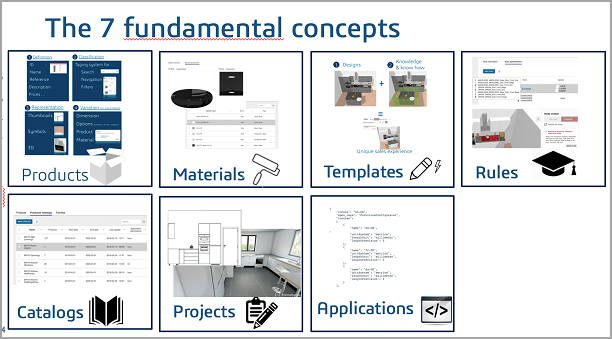Implement the Platform
Core Range Concepts
The ByMe platform defines all the fundamental concepts needed to build and deploy a 3D planning application.
Simpler applications and simpler ranges do not require the implementation of all concepts.

Implementing the ByMe Platform
ByMe customers managing their range need to take care of the following aspects, which are not currently in the scope of the ByMe platform.
Primary Storage, Versioning
The platform is neither a PIM nor a PLM platform. Lifecycle management (including iteration management, versioning, maturity), completeness of information concepts are not part of the fundamentals delivered by the ByMe platform. Therefore, the platform shall not be used as the single source of truth for the customer range data. In other words, the ByMe platform is not, range-wise, an authoring platform but a publishing platform.
The customer adopting a HomeByMe solution has to procure its own Range Management System (possibly based on a combination of a PIM and or a PLM) which in turns publishes the range, and its updates, to the ByMe platform.
Workflow
No workflow is enforced in the ByMe platform, in order to maximize the flexibility and adaptability of Range Management processes delivered to ByMe customers.
The range publishing workflow has to be built in the Range Management System by the customer according to its processes and constraints. Here are a few typical questions for which our customers have different answers:
Can a product be defined without a 3D model?
Can a product be incompletely defined in the platform–typically in a transient fashion, the reference and 3D coming first, and the price and description coming later in the range creation process?
This is frequent, and one of the reasons why the ByMe platform does not enforce product completeness.
Which actor is able to run which steps of the range management process?
What is the range validation strategy?
Recovery from Applicative Data Corruption
ByMe customers manage their range, in the ByMe platform, in the scope of their dedicated Legal Entity(s).
The ByMe platform manages storage, and provides resilience capabilities such as backup and restore to handle recovery after catastrophic events originating from the infrastructure or platform software.
The ByMe platform is multi-tenant, meaning this storage is shared between customers, albeit each ByMe customer's data is isolated from the others through logical partitioning at the Legal Entities level.
Consequently, it is not possible to leverage the platform resilience capabilities to recover from data mishaps of one customer, as this would impact others. The Range Management system should be able to republish data to restore a proper state of some or all the legal entities it owns.
Bounding your Namespace
The namespace for the identification of many of the object types in the platform is global to all of our customers. This means it might be impossible to use a given object identifier because another customer is already using it, or because it is used by the same customer albeit in a different Legal Entity. Our recommendation is to prefix all identifiers with a specific token, at the Legal Entity level.
This pattern is common to many other cloud services such as for example Amazon Web Services Simple Storage Service (S3) where bucket name is unique across all AWS accounts.
Product Visibility Business Logic
The platform manages product start date and end date, as well as a Boolean visibility status ("enabled" in the product API). The platform does not provide internal support for complex logic such as a product visibility depending on the combination of information regarding sourcing, pricing, supply management... Product visibility status has to be calculated in the customer Range Management System, and the result published to the ByMe platform.